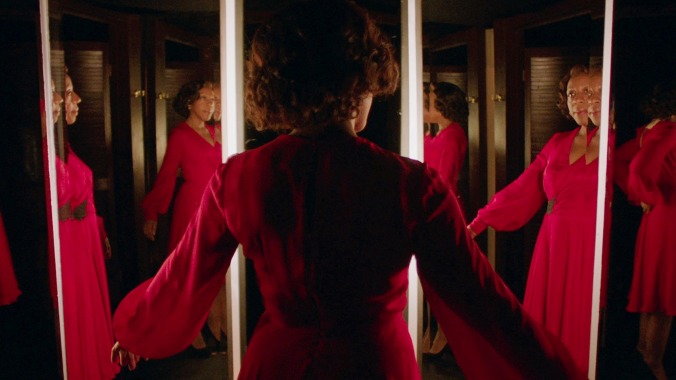Horror movies about inanimate objects possessed by anthropomorphic bloodlust tend to lean more on the exploitation side. There’s 1977’s Death Bed: The Bed That Eats, made famous by a Patton Oswalt stand-up routine; more movies than you might think about killer elevators; killer phones and phone calls, practically a genre unto themselves; and, most recently, Killer Sofa, released on VOD just this October. Then there’s In Fabric, an arthouse variation on the killer-object theme from Peter Strickland, the celebrated British director of The Duke Of Burgundy and Berberian Sound Studio. Like those films, In Fabric gathers up an evocative collection of retro stylistic tropes and pastes them into a sort of fetishistic cinematic scrapbook. Unlike those films, it’s sewn together loosely, with the potential to unravel if any of its many threads are pulled on too hard. Did we mention it’s about a dress that kills people?
But while the dress does flit around the screen of its own volition, chiffon fluttering in an inexplicable indoor breeze, it doesn’t completely have a mind of its own. It’s controlled by a Suspiria-esque coven of what can only be described as Italo-horror mannequin witches, who exclusively dress in Victorian mourning wear, live deep within the bowels of old-fashioned department store Dentley & Soper’s, and talk in a hilariously grandiloquent version of retail sales-speak. “A purchase on the horizon, a panoply of temptation. Can a curious soul resist?” This is how occult saleswoman Miss Luckmore (Fatma Mohamed) greets Sheila (Marianne Jean-Baptiste), a middle-aged divorceé who pops in to Dentley & Soper’s for a new dress to wear on a date. She ends up settling on an “artery red” number that also happens to be cursed.
This isn’t an EC Comics-style morality tale. Sheila is a good person, tolerant of the hypersexual relationship between her son, Vince (Jaygann Ayeh), and his condescending girlfriend, Gwen (Gwendoline Christie). She’s also patient with the Kafkaesque jargon spewed by middle managers Stash (Julian Barratt) and Clive (Steve Oram) at the bank where she works. Her only sin is loneliness: An offhand comment about her ex’s new girlfriend at the beginning of the film spurs her to join a “lonely hearts” phone messaging service, eventually leading her to Dentley & Soper’s in search of something to wear. There’s both horror and melancholy to Sheila’s story, though both are ultimately overwhelmed by its laugh-out-loud absurdity. That’s especially true when the film abruptly shifts to a new storyline a little more than halfway through, chronicling the haunting of washing machine repairman Reg Speaks (Leo Bill) after he receives the dress, freshly purchased from a secondhand store as a bachelor party gag gift.
This two-pronged structure ends up being In Fabric’s biggest weakness, highlighting the thinness of the plot by repeating the same unnecessary scenes—mostly of the workplace variety—in both storylines. Reg also isn’t as compelling of a character as Sheila, who Jean-Baptiste imbues with a vulnerability that keeps her portion of the film grounded, even when everything around her is abstract in the extreme. Reg’s storyline is more dependent on a pair of alienating gags: First, his ability to hypnotize his customers with boring jargon, and second, the crushing suburban ennui of his relationship with his hectoring fianceé, Babs (Hayley Squires). Sheila’s humanity is a necessary counterbalance to Strickland’s intentionally stiff, formal style, which manifests in the film’s efficient pacing and crisp sound editing as well as its stylized performances and lavish production design.
There are moments of artistic indulgence within In Fabric, to be sure—take the slo-mo closeup of semen arcing across the screen, or the flashback to the exact moment in Reg’s childhood that gave him a stockings fetish. But they’re all so bizarrely inspired that they’re oddly endearing, particularly if you’ve already got a taste for giallo-inspired strangeness. What’s less engaging is the suspicion that neither of these stories was substantial enough for a feature film on their own, and so they were combined to make a justifiable whole. The film’s demented satire of consumer culture and weird diversions into psychosexual nightmare fuel are less reliant on a coherent narrative arc, however, and Strickland’s unique ability to convey the sense of touch in an audio-visual medium isn’t dependent on story at all. And so while this isn’t the best movie to introduce someone to the strange, sexy world of Peter Strickland—that would be The Duke Of Burgundy—there will be no buyer’s remorse for anyone who’s already a member of the cult.



 Keep scrolling for more great stories from The A.V. Club.
Keep scrolling for more great stories from The A.V. Club.